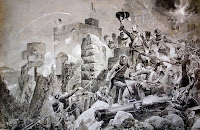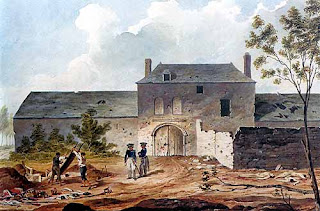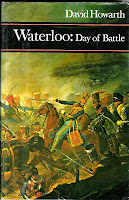 Hello! Since Cara was Diane yesterday, I suppose I am being Cara today (though sadly without a Trusty Todd). I’m going to share some of the sources I’ve used while researching my current hero’s backstory. Please bear in mind that though I may call myself a History Geek (and certainly know more than the average person in the street), my knowledge of the battle is still evolving.
Hello! Since Cara was Diane yesterday, I suppose I am being Cara today (though sadly without a Trusty Todd). I’m going to share some of the sources I’ve used while researching my current hero’s backstory. Please bear in mind that though I may call myself a History Geek (and certainly know more than the average person in the street), my knowledge of the battle is still evolving.
I began my research with WATERLOO: NEW PERSPECTIVES by David Hamilton-Williams. This book is immensely detailed and to the best of my knowledge, correct and scholarly; it is also very Napoleon-friendly. For instance, there are frequent references to Napoleon being “betrayed” by both his enemies and his officers and little or no mention of the physical ailments mentioned in other sources that might have impaired his abilities on the fateful day. Though I found it excellent and detailed, I found it off-putting that it treated the events more as a tragedy for Napoleon than for the tens of thousands who were killed or wounded and their families.
 The next book I read had a different focus. WATERLOO: DAY OF BATTLE by David Howarth, provides an overview of the events, but places the emphasis on the experience of individual officers and soldiers, whose stories (for Waterloo is not one story but many) are traced through the battle and its aftermath. It draws heavily on firsthand accounts of the battle written by participants on both sides, is eminently readable, and may have you crying at points. (I did.) If you want to read just one book about Waterloo, this should be the one.
The next book I read had a different focus. WATERLOO: DAY OF BATTLE by David Howarth, provides an overview of the events, but places the emphasis on the experience of individual officers and soldiers, whose stories (for Waterloo is not one story but many) are traced through the battle and its aftermath. It draws heavily on firsthand accounts of the battle written by participants on both sides, is eminently readable, and may have you crying at points. (I did.) If you want to read just one book about Waterloo, this should be the one.
 Some of my favorite references on Waterloo are firsthand accounts: letters, journals, memoirs. Beyond all the amazing details one cannot find in regular histories, I love the insights these accounts of Waterloo provide into the minds and hearts of those who fought there. Here are some quotes from ones I’ve read so far (there are many more on my TBR list).
Some of my favorite references on Waterloo are firsthand accounts: letters, journals, memoirs. Beyond all the amazing details one cannot find in regular histories, I love the insights these accounts of Waterloo provide into the minds and hearts of those who fought there. Here are some quotes from ones I’ve read so far (there are many more on my TBR list).
From THE WHEATLEY DIARY by Edmund Wheatley:
“I concluded that you, my Dearest Eliza, you, whom I always regretted, I was certain was asleep innocent and placid. The pillow that supported you was unconscious of its lovely burthen. But the breast, then cold and chilled with the prospect of approaching dissolution, felt that morning one or two warm sensations. It is an awful situation to be in, to stand with a sharp edged instrument at one’s side, waiting for the signal to drag it out of its peaceful innocent house to snap the thread of existence of those we never saw, never spoke to, never offended.”
Wheatley fought in the King’s German Legion and participated in an ill-fated advance ordered by the Prince of Orange in a fit of idiotic stubbornness. The KGL, formed in line rather than square, were hacked apart by French cavalry; Wheatley’s commander, Colonel Ompteda, was killed; Wheatley himself was injured, taken prisoner and treated brutally by French before he managed to escape.
 From ADVENTURES IN THE RIFLE BRIGADE by Sir John Kincaid:
From ADVENTURES IN THE RIFLE BRIGADE by Sir John Kincaid:
“[Sir James Kempt] called to me by name, where I happened to be standing on the right of our battalion, and desired ‘that I should never quit that spot.’ I told him that he might depend upon it: and in another instant I found myself in a fair way of keeping my promise more religiously than I intended; for, glancing my eye to the right, I saw the next field covered with the cuirassiers, some of whom were making directly for the gap in the hedge where I was standing. I had not hitherto drawn my sword, as it was generally to be had at a moment’s warning: but, from its having been exposed to the last night’s rain, it had now got rusted in the scabbard, and refused to come forth! I was in a precious scrape!”
“I had never yet heard of a battle in which everybody was killed; but this seemed likely to be an exception, as all were going by turns.”
“The usual salutation on meeting an acquaintance of another regiment after an action was to ask who had been hit? but on this occasion it was, ‘Who’s alive?'”
Kincaid survived the battle without injury but wrote that it was “the last, the greatest, and the most uncomfortable heap of glory that I ever had a hand in”.
 From A BRITISH RIFLE MAN, by George Simmons:
From A BRITISH RIFLE MAN, by George Simmons:
“I had an impression I should not be touched, and was laughing and joking with a young officer about half-past four in the afternoon. At this time I was a little in front of our line, and hearing the word charge, I looked back at our line, and received a ball, which broke two of my ribs near the backbone, went through my liver, and lodged in my breast. I fell senseless in the mud, and some minutes after found our fellows and the enemy hotly engaged near me.”
Simmons had to ride twelve miles to get back to Brussels and the house where he’d been billeted earlier. His life hung in the balance for a time and he worried mightily about his large family, to whom he’d been sending a good portion of his modest earnings. But he was nursed carefully and ultimately made a recovery.
Later Kincaid gives this account of his fellow officers post-Waterloo.
“Beckwith with a cork leg; Pemberton and Manners each with a shot in the knee, making them as stiff as the other’s tree on; Loftus Gray with a gash in the lip and minus a portion of one heel, which made him march to the tune of dot and go one; Johnston, in addition to other shot-holes, with a stiff elbow, which deprived him of the power of disturbing his friends as a scratcher of Scotch reels on his violin; Percival with a shot through his lungs; Hope with a grape-shot lacerated leg, and George Simmons with his riddled body held together by a pair of stays, for his was no holy day waist which naturally required such an appendage lest the burst of a sigh should snap it asunder, but one that appertained to a figure framed in nature’s fittest mould to ‘brave the battle and the breeze!'”
I hope you found this interesting. Do you have any favorite Waterloo references to share?
Tomorrow I will blog again (as Elena this time!) on films dealing with Waterloo.
Elena
www.elenagreene.com
 So many of you have been sooooo kind to be thinking of my struggle to finish this book and wishing me well.
So many of you have been sooooo kind to be thinking of my struggle to finish this book and wishing me well.

























